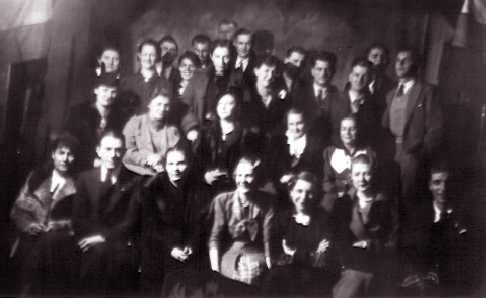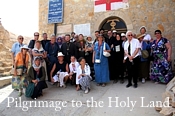The Russian Orthodox Society of the City of Vancouver

The young generation in 1936, lower floor of church house:
First row: E. P. Rozvaliaev, F. Chaikovsky, A. Tseplyaiev, N. Sinitsina, Z. Sinitsina,
A. Portnova, A. Zotov, A. Portnov
Second row: N. Podlegaieva, unknown, M. Pashkovsky, R. Demintseva, F. Durova
Third row: N. Zotova, I. Balakshina, Z. Fetisova, A. Zukerberg, V. Portnova,
V.Pashkovsky, P. Karavai, I. Patsali, E. Pahomov
Fourth row: S. Rozvaliaev, B. Fetissov, I. Podlegaiev, V. Zotov, N. Karavai
In 1930 the Great Depression hit Canada. To make matters worse, the Immigration authorities were issuing landing permits on the condition that the new immigrants should spent first two years in farm work. Many Russians arriving in Vancouver found trains bound to Alberta and Saskatchewan awaiting them at the dockside. Fewer Russians were now permitted to join relatives in Canada.
But despite the hard times, Russian culture activity in Vancouver reached its peak in the early 1930s. The first benefit concerts were staged at Hotel Vancouver and the Commodore Cabaret for the Russian Veterans of the Great War resided in Europe. There was enough artistic talent to produce classical operas and operettas: Boyar Wedding, Natalka-Poltavka, Zaporozhtsy za Dunayem. Especially splendid was The Geisha performed at the Peter Pan Hall. To name just some of the artists involved: Lidia A. Panovsky (Kritova), Elizaveta A. Kozina, Gerhard A. Olly, Alexander S. Znamensky, Pyotr D. Patsali, Valentin S. Kukuruza, E. Y. Fetisoff, A E. Portnoff, Mila and Seraphima Pashkovsky, Boris Novikoff. In 1935 the Don Cossack Choir under Sergei Zharov came to Vancouver for the first time and visited the church.
The Vancouver public received these productions very enthusiastically. Part of the box office take went into the Church treasury for mortgage payments. The beautiful new church was well attended and lovingly decorated. Several icons were received as gifts, including the icon of St. Innocent of Irkutsk.
In 1932 the Church house basement was reconstructed to house a dining room and the library. The dining room was decorated with a wall painting of a birch grove, and Russian people spent many fine evenings there. The lending library was started and managed for many years by Mr. K. N. Mamontoff. Beginning with just one bookshelf, he put together a large collection.
In October of 1931, Fr. Gregory Prozoroff was transferred to Sitka, Alaska.
Fr. Alexander Kiziun of Edmonton was appointed Rector of Holy Resurrection Church and arrived in December 1931. He was very energetic and helped people any way he could. Many people with no work and no place to go would come to Fr. Alexander for spiritual support.
In July 1933, several Russian families in the Abbotsford area created a Brotherhood for the purpose of building a chapel . The Sts. Peter and Paul chapel was dedicated by Fr. Alexander Kiziun on Dec.30.
In 1933, G. A. Maltsev arrived from China and greatly improved the church choir in his three years of direction. E. A. Andreyev succeeded him.
In 1934, Valentin Yakovlevich Podlegayev became Church Warden and worked very dutifully for many years.
Still, more and more of the parishioners lost their jobs, and the mortgage and bank loan payments were in arrears by 1934. Mr. W. B. Sterling of Burquitlam, owner of the mortgage, initiated court proceedings to repossess the church property.
In 1935 the financial crisis threatened the parish’s existence, when creditors seize the church building. On the initiative of Mr. V. A. Mironoff, the Russian Orthodox Society (ROS) was created and incorporated on July 1, 1935 with 36 founding members. Rent payments were resumed, and the church reopened.
The debt was paid off in monthly installments of $40. Unemployed members paid their dues with labor. The Society became the legislative and administrative body, owner and manager of the church. It set up committees for various kinds of work – Ladies, Youth, Dramatic, Musical, Aid to Russian Invalids, plus Library and Russian School. A Ladies’ Auxiliary and a Russian Youth Circle were formed, affiliated with the ROS. A Russian school was established; Mr. A. F. Zukerberg was the first teacher.
Eventually tensions arose between the ROS and the Rector, who objected to the handling of current church business by the Council. In August 1937 Fr. Alexander Kiziun left the parish, and with his own labour and his patron’s funds he built the Holy Trinity Church on Campbell Avenue. The new parish joined the Russian Church Abroad. At that time, the Karlovtsy Synod and the North American Metropolia were in co-operation.
Priest-monk Anthony (Vasilieff) of Toronto accepted the offer made by the ROS and was appointed Rector. He arrived on the last day of 1938.
In 1939 the Church choir performed its most memorable recital at Christ Church Cathedral. The mortgage was finally paid off by year’s end. Fr. Anthony (Vasilieff) announced his resignation in November 1939. Several priests were contacted about replacing him.
In 1930-1937, His Grace Arseny, Bishop of Winnipeg and Canada celebrated the Pontifical Liturgy at least once a year, until his retirement.

 Russian Version
Russian Version Orthodox Tours
Orthodox Tours Pilgrimage to the Holy Land – 2010
Pilgrimage to the Holy Land – 2010
 Archangel Michael Orthodox Christian Mission, Kelowna
Archangel Michael Orthodox Christian Mission, Kelowna Archdiocese of Canada
Archdiocese of Canada Canadian Orthodox History Project
Canadian Orthodox History Project Monastery of All Saints of North America, Dewdney
Monastery of All Saints of North America, Dewdney Orthodox Church in America
Orthodox Church in America